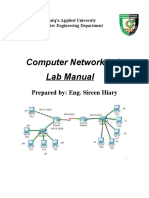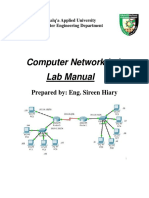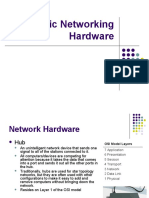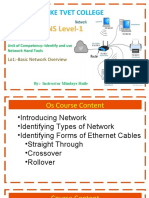0% found this document useful (0 votes)
23 views7 pagesComputer Network
The document provides an overview of various network devices including hubs, switches, routers, bridges, and repeaters, detailing their functions, operational layers in the OSI model, and their roles in network efficiency. It also covers cabling standards, specifically the RJ-45 connector and wiring standards (T568A and T568B), as well as crimping tools for connecting cables. Additionally, it discusses different types of network cables (twisted pair, coaxial, and fiber optic) and categorizes networks into LAN, WAN, and MAN based on geographical scope and data transfer rates.
Uploaded by
karinachoudhary125Copyright
© © All Rights Reserved
We take content rights seriously. If you suspect this is your content, claim it here.
Available Formats
Download as PDF, TXT or read online on Scribd
0% found this document useful (0 votes)
23 views7 pagesComputer Network
The document provides an overview of various network devices including hubs, switches, routers, bridges, and repeaters, detailing their functions, operational layers in the OSI model, and their roles in network efficiency. It also covers cabling standards, specifically the RJ-45 connector and wiring standards (T568A and T568B), as well as crimping tools for connecting cables. Additionally, it discusses different types of network cables (twisted pair, coaxial, and fiber optic) and categorizes networks into LAN, WAN, and MAN based on geographical scope and data transfer rates.
Uploaded by
karinachoudhary125Copyright
© © All Rights Reserved
We take content rights seriously. If you suspect this is your content, claim it here.
Available Formats
Download as PDF, TXT or read online on Scribd
/ 7






















































































